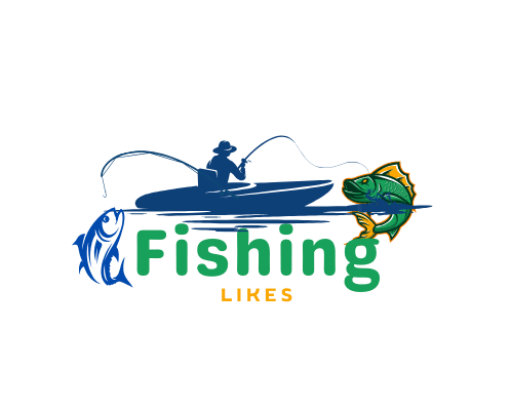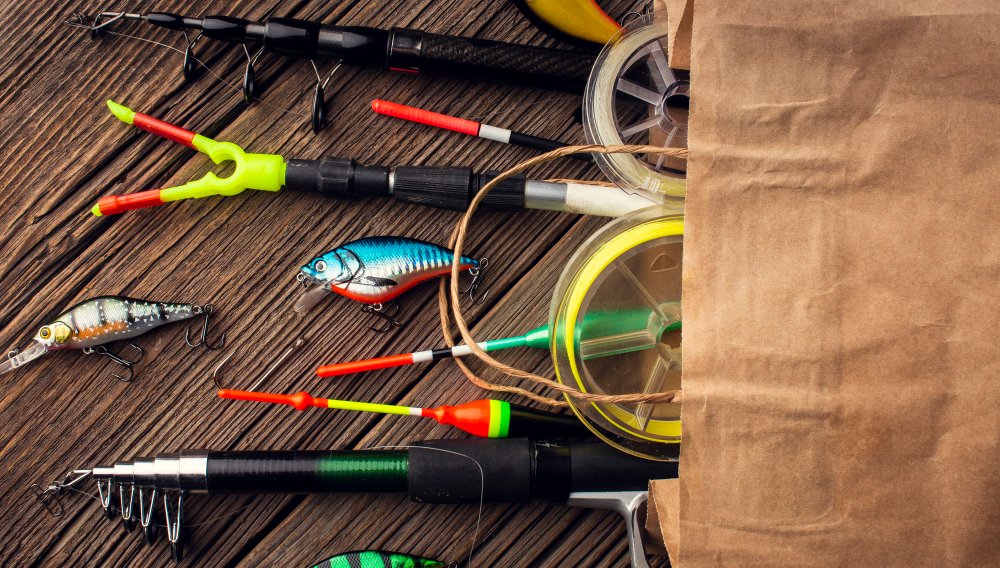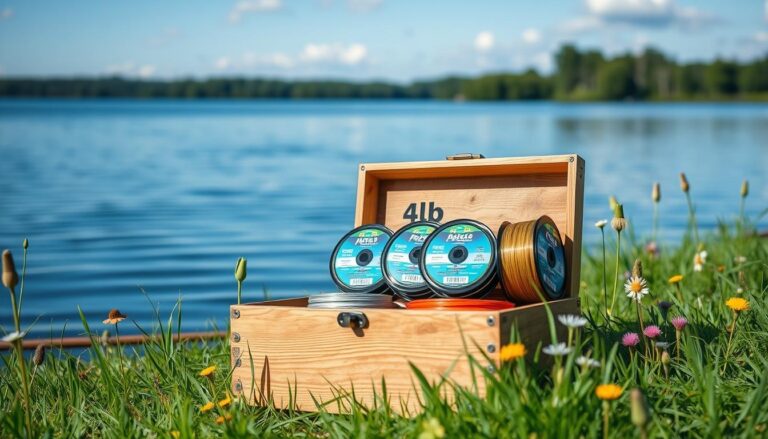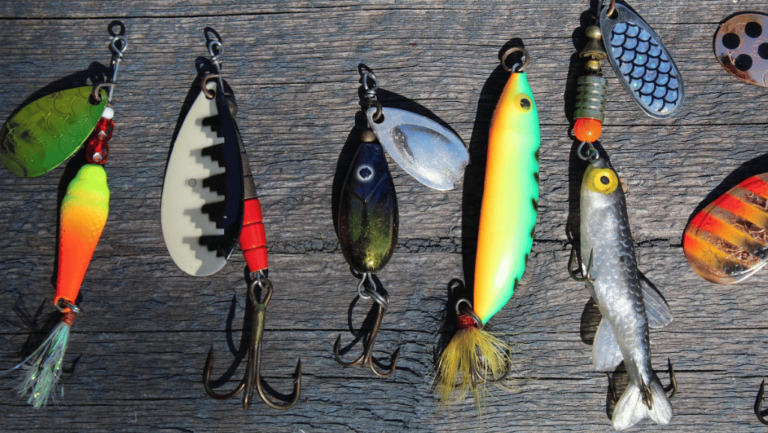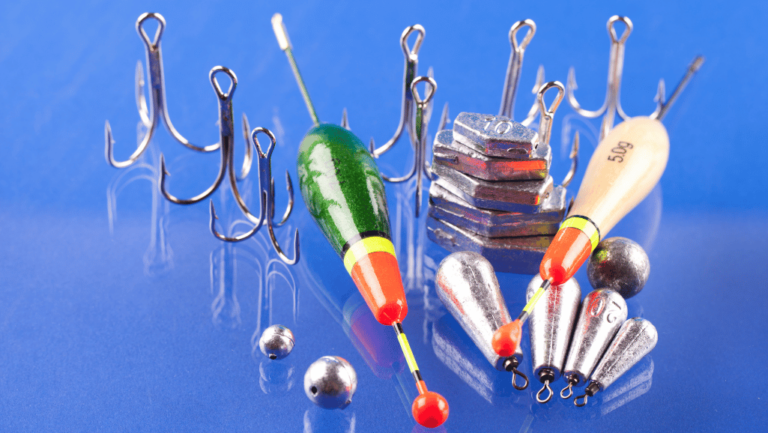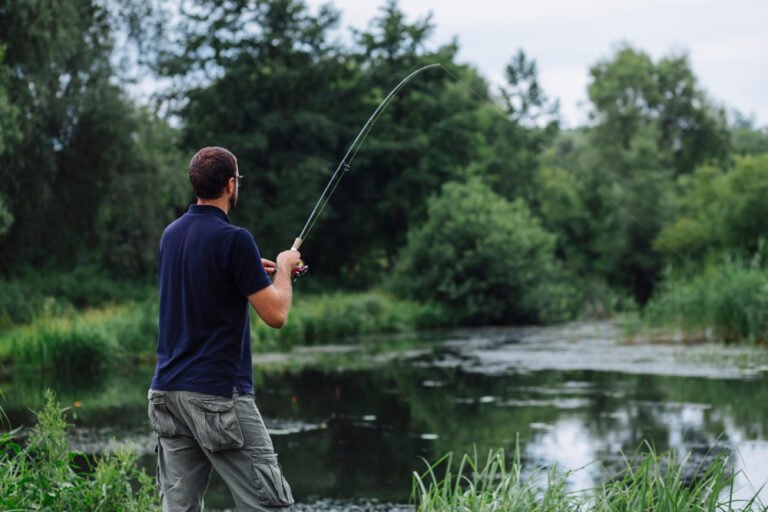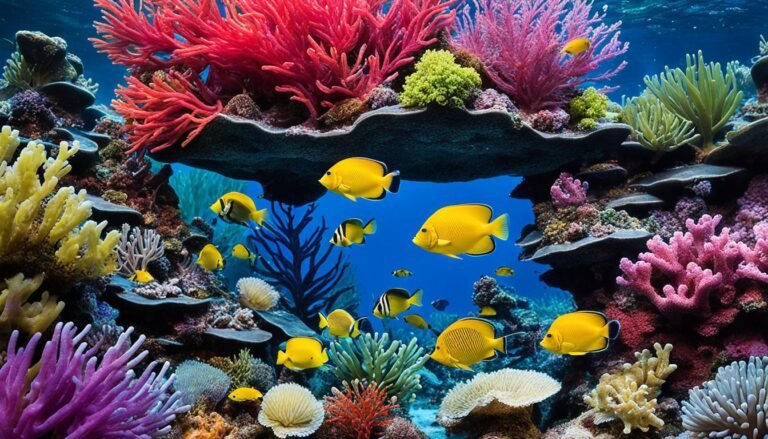Are you wondering how do I fish for the first time? This guide is here to get you started with the spinner method using a spinning reel. You’ll find that starting your fishing journey is not only fun but also cheap. Day fishing licenses cost less than $20, and yearly ones range from $30 to $150. With a few tips and a small gear investment, you could be catching fish by the weekend.
For those just starting, lakes are a great place to learn. They’re full of fish like bass, panfish, and rainbow trout. Lakes offer good fishing chances because they have lots of fish to catch. It’s important to learn some basic stuff, like how to use a spinning reel and rod. Also, learn some essential fishing knots, like the improved clinch knot and Palomar knot. Knowing these basics will help make your fishing trip a success.
Being polite when fishing is very important too. Make sure to keep at least 50 to 60 feet away from other people fishing in busy spots. And, it’s good to follow the rules on when to let a caught fish go. With time and a bit of work, you could become really good at fishing. You might even want to try cool things like fly-fishing as you get better.
Key Takeaways
- Day fishing licenses cost less than $20, while annual licenses typically range between $30 and $150.
- Lakes are recommended for beginners due to the larger volume of fish such as bass, panfish, and rainbow trout.
- Leaving space of 50 to 60 feet between anglers and adhering to catch and release regulations is essential fishing etiquette.
- A spinning reel and rod combo is suggested for beginners for easier setup.
- Learning basic knots like the improved clinch knot, Palomar knot, and double surgeon’s knot is vital.
Getting Started with Fishing
Starting your fishing hobby is exciting and fun. It’s important to learn about the gear and techniques. We’ll go over everything you need to know to get going on this amazing adventure.
Essential Items to Begin Fishing
To start fishing, you need a rod and reel, lures or bait, and some key accessories. For new anglers, look into spin-casting and spinning reels as a start. You can find fishing kits at outdoor stores. These include what you need and help with conservation.
For your line, a 4 to 12-pound-test monofilament is best. Don’t forget sinkers and a rubber glove with a net for handling fish. Always wet your hands before handling a fish to protect them.
Understanding Fishing Licenses
Knowing the fishing rules in your state is key. For freshwater fishing, you’ll need a state fishing license. These permits outline what’s allowed, like fish types and sizes. A day license usually costs less than $20, while yearly permits range from $30 to $150.
| License Type | Price Range |
|---|---|
| Day License | Under $20 |
| Annual License | $30 – $150 |
Basic Fishing Techniques
Knowing the basics makes fishing more enjoyable. Try starting at lakes, where you can find species like bass and trout. Fishing apps can help you find the best spots. Fishbrain and FishAngler are useful tools.
Fishing right means not getting too close to others and handling fish with care. Always think about the environment. Try not to litter and learn about local conservation. You can also borrow fishing gear to improve your skills.
Choosing the Right Fishing Gear
Choosing the right fishing gear is key for a great time on the water. It doesn’t matter if you’re new or upgrading. You need to know about rods, reels, lines, and hooks. This helps you set up for success.
Types of Rods and Reels
Fishing rods vary greatly in length, from 4 to 14 feet. Each length has its pros and cons for casting and handling. Let’s look at the different rod types:
- Fiberglass Rods: They’re tough and cost-effective, making them good for beginners. However, they might not feel the most delicate and can be heavy.
- Graphite Rods: These are known for being light and sensitive, but they can break more easily and are pricier.
- Composite Rods: With a mix of graphite and fiberglass, they’re flexible and not too heavy. Yet, they’re usually the most costly.
Each rod also has an ‘action,’ which tells you how much and where it bends when you catch a fish.
- Fast Action Rods: Respond well to small bites. They’re good for catching large, strong fish like Tuna.
- Medium Action Rods: These are great for different types of fishing and handling fish of various sizes.
- Slow Action Rods: They bend a lot and are best for smaller fish.
Reels are another important part. Beginner anglers usually start with:
- Spincast Reels: They’re easy to use and great for starters.
- Spinning Reels: These give more control and can cast further.
- Baitcasting Reels: They offer precise casting but need more skill.
Fishing Line and Hooks
Choosing the right fishing line is crucial. You can pick from:
- Monofilament Lines: They’re affordable and easy to work with.
- Braided Lines: These are very sensitive but can be tricky to tie.
- Fluorocarbon Lines: They’re between the first two in stretchiness and are often the best for leaders.
Don’t forget about hooks. Pick them based on how big the fish you’re aiming for is. Also, some hooks might not be allowed in certain places. Know the local rules.
- Legal Considerations: Be aware that some hooks may be illegal in some regions. Knowing the regulations is crucial.
Accessories You Need
Other important fishing gear includes:
- Bobbers: They help you keep track of your bait’s depth.
- Proper Net: Essential for safely bringing in your fish.
- Bait and Lures: For starters, live bait like worms or artificial bait like PowerBait work well.
- Pliers: These are for safely removing hooks from fish.
Local fishing shops are a great place to get more advice and find specialized gear. They can tell you what’s best for your fishing spot.
How to Select the Best Bait for Fishing
To pick the best bait for fishing, you need to know your fishing spot. You must study what the local fish eat and the water conditions. This will help you choose the right bait.
Live bait is a top pick. It moves naturally and attracts fish around the world. On the other hand, dead bait lasts longer and leaves a strong scent. It’s great for fishing in dark water or when fish hunt by scent.
Artificial bait is another choice. It comes in different shapes, sizes, and colors. You can pick the best one for where you’re fishing and what type of fish you want to catch. For example, use bright chartreuse in green water, white in clear water, and dark root-beer in stained water.
We’re giving you a detailed look to help choose the best bait for any situation:
| Bait Type | Advantages | Ideal Conditions |
|---|---|---|
| Live Bait | Natural movement, highly effective | Most fishing environments |
| Dead Bait | Longevity, strong scent trail | Murky waters, scent-based fishing |
| Artificial Bait | Versatile, customizable | Varied, depending on color and type |
To choose the right bait, also think about how you’ll get it. You can catch bait, make it at home (great for chum), or buy it from different places like tackle shops or marinas.
Perfecting Your Casting Techniques
Learning casting techniques well is key for fishermen wanting to cast far and accurately. This part will guide you step by step. It offers tips to avoid mistakes that might hurt your fishing.
Step-by-Step Casting Guide
Having the right set up is very important. Make sure your fishing reel is full with the right amount of fishing line. This can help you cast further. When fishing near the shore, a lead of five or six feet can be handy. Using braided fishing line is good because it can cast farther than mono line due to its thinness.
- Prepare your rod and reel: Keep the reel spool filled to the maximum capacity for better distance.
- Choose the right knot: A smaller, wind-on style knot provides better control over casting accuracy.
- Select the appropriate casting technique: Use a side-arm cast for pitching lures underneath docks or overhanging structures, while a pendulum cast is ideal for tight spaces like between pilings and groins.
- Practice your cast: Utilize a casting plug to hone your technique. Accurate casting can significantly increase your chances of hooking fish.
Common Casting Mistakes to Avoid
Even skilled fishermen can mess up their casts. Here are errors you should watch out for:
- Premature Line Release: Letting go of the line too early leads to short casts. Release it as your rod tip peaks.
- Late Line Release: Holding the line too long can make your cast flop. Let go just before the rod aims at your target.
- Improper Gear Selection: The wrong fishing rod and reel can mess with your aim. Match your gear to the lure and fishing style.
- Neglecting Maintenance: Not cleaning your gear after fishing can make salt build up. This can make your casts weaker. Clean your gear regularly for best results.
To get better at casting, always be ready to change your method based on how you’re doing. Even getting a cast within an inch of your target can improve your catch rate a lot. Look at your gear and make smart changes to fish better.
Understanding Fishing Etiquette
Knowing the basics of fishing etiquette is key for a great time. Being considerate ensures all fishers have fun. This builds a friendly atmosphere by the water.
Respecting Other Anglers
Fishing etiquette requires keeping your distance. Fishing too close can mess up the lines and stress everyone out. In small spots, like narrow streams, it’s even more important to spread out.
Keeping quiet is also essential. Loud noises scare off fish and bother others. So, talk softly and skip the loud music. This makes the fishing spot calm and good for catching fish. It’s all about being mindful and respecting peace to follow fishing etiquette.
Ethical Fishing Practices
Using ethical practices help keep fish and their homes healthy. Follow the rules, like not overfishing, and respect when certain fish can’t be caught. Don’t forget your permits, they make sure you’re doing things right.
Anglers should only catch what they really need. Throw back any extra fish and use gear that doesn’t harm fish. Always clean up after yourself. Leaving trash makes fishing spots dirty. This isn’t good for anyone.
Always ask before fishing on private land. This shows respect and makes fishing nicer for everyone. Helping new fishers learn makes the fishing community better. It’s great for sharing and caring about fishing properly together.
An effective table to outline some important aspects of fishing etiquette and ethical practices is given below:
| Aspect | Description |
|---|---|
| Distance Between Anglers | Keep ample space to avoid tangled lines and stress. |
| Noise Control | Maintain low volumes to avoid scaring fish and disrupting others. |
| Trash Cleanup | Dispose of all trash properly to keep fishing areas clean. |
| Respect Private Property | Seek permission before entering or fishing on private land. |
| Abide by Regulations | Observe catch limits and obtain the necessary permits. |
| Ethical Fishing | Engage in practices like catch and release and take only what you need. |
How Do I Fish: Basic Steps Explained
Ever thought, how do I fish? Here’s a simple guide to start. First, gather your gear. You need a rod, reel, hook, line, and sinker.
- Setting Up Your Rod: Connect the reel to the rod first. Then, thread your fishing line through the rod’s guides. Tie the line securely to the reel with a strong knot like the Palomar knot.
- Choosing the Right Hook and Bait: Pick hooks and bait that match the fish you want. For beginner fishing tips, go with live worms or PowerBait. They work well.
Casting Techniques: Now, learn how to cast. Hold your rod at a 45-degree angle. Then, let your line go and swing your rod. Make this move smooth and steady.
- Choosing the Right Time: The best time to fish is at dawn or dusk. Fish are more active then, which improves your chances of catching something.
- Understanding Bites: Feel a tug on your line? It could be a bite. Wait a moment before pulling the rod. Let the fish hook itself first.
- Reeling in Your Catch: Now, start bringing in your catch. Do it slowly and evenly. Keep your rod tip up and the line tight. Set your reel drag to one-third the strength of your line to avoid breaking it.
| Fishing Aspect | Tips and Recommendations |
|---|---|
| Best Time to Fish | Dawn and dusk are ideal. |
| Lures and Baits | Chartreuse for green waters, white for clear waters, and root-beer for tannic-stained waters. |
| Reel Drag Setup | Set to one-third of the line’s rated breaking strength. |
| Hook Maintenance | Always use new or sharpened hooks. |
Learning how do I fish is key. These beginner fishing tips will improve your skills with practice. Also, consider extra help like fishing guides to get better faster.
Finding the Best Fishing Locations Near Me
To find great fishing locations near me, start with tools like Google Earth and Google Maps. These techs provide key info for anglers. You can see lakes, rivers, and the coast. Plus, you’ll find detailed 3D views that show where the fish might be.
Navionics and Lake Master Contour Elite are also great. They give detailed maps of the water. With this and knowing when fish move, you can pick the best spots.
Keep an eye on the water level changes. This could uncover new spots to fish. It’s how some anglers find great but little-known places.
Places like wildlife refuges can help a lot, especially for new anglers. They offer tips and sometimes even fishing gear. This makes your fishing trip more enjoyable and successful.
Google Maps is good for finding your way, even on the water. It shows boat ramps and paths clearly. On the other hand, Google Earth lets you plan and keep track of good fishing spots.
For boaters, these tools are invaluable. They show different water depths and help find the right spots to fish. With mapping tech, you can build a list of reliable fishing spots near you.
| Tool | Features | Best For |
|---|---|---|
| Google Earth | 3D satellite views, marking locations, recording catch details | Detailed planning, identifying fishing features |
| Google Maps | Labels, navigation, locating boat ramps | General navigation, exploring new areas |
| Navionics, Lake Master Contour Elite | High-definition contours | Mapping underwater topography |
Reading Water to Locate Fish
Learning how to read water is vital for anglers who want to catch more fish. Biologists say 80 to 90 percent of a fish’s diet is below the surface. So, it’s critical to look past what we can see on top.
By spotting areas with lots of weeds or big trees under the water, we can guess where fish are. In rivers, places like logjams or shady banks are great for fishing. These spots offer fish a safe place to hide and food to eat.
Seeing how the water moves or noticing things like bubbles can show us which flies to use. This can hugely boost our chances of catching something. It’s key to pay attention to details like the water’s depth and how clear it is while fishing.
Using a map that shows underwater features can also be a big help in finding good fishing spots. Watching birds that eat from the water can give us clues on where to look as well. These birds often eat the same tiny fish or insects that the larger fish hunt.
MidCurrent’s guide on reading water and finding fish is a great place to learn more.
Improving your ability to observe and understand fish behavior means better fishing. These skills not only help make your fishing trips successful but also more enjoyable.
